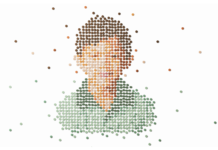It has been 500 years since Leonardo da Vinci died in May of 1519. Since that time, the fame of that most quintessential renaissance man has been unrivaled. Producing some of the most famous paintings in the Western art tradition—the Mona Lisa, The Last Supper, and the Vitruvian Man, for example—da Vinci was also a tireless inventor. He is known for inventing parachutes, tanks, and the helicopter, centuries before those devices would be built. Many of his less well-known inventions, however, did become commonplace in the years after his death. A consummate scientist, da Vinci made discoveries in various fields, and his anatomical drawings were revelatory for the time period.
Now, in a short editorial in the scientific journal Brain, neuroscientists Marco Catani and Paolo Mazzarello present their pet conjecture: they want to diagnose da Vinci with ADHD. The paper is written in an unusual format for a scientific journal, lacking the usual sections providing evidence for claims and justifying a conclusion. Nevertheless, Catani and Mazzarello make their theory clear:
“We suggest that historical documentation supports Leonardo’s difficulties with procrastination and time management as characteristic of ADHD, a condition that might explain aspects of his temperament and the strange form of his dissipative genius.”

The authors don’t mention that it is considered a breach of ethics in psychiatry to make a diagnosis without meeting the client—one of the reasons that armchair diagnoses of presidents and other public figures are frowned upon. This can only be more serious if the person in question is only known through posthumous biography and the words of others from five hundred years ago.
In an almost cursory fashion, Catani and Mazzarello lay out their case. Leonardo was continually thinking of new things, making discoveries, and working on new pieces of art. His patrons found him difficult to control. When he struggled to paint something, he developed entirely new materials for painting—which sometimes took too long. He struggled to make money. Although he took voluminous notes, beautifully illustrated, he rarely seemed to care about publishing his work.
The authors thus arrive at the diagnosis of ADHD. They do not discuss alternative theories (as the usual differential diagnosis procedure in psychiatry would dictate). For instance, another psychiatrist might develop a different explanation for Leonardo’s nonstop flight of ideas, lack of sleep, and the ability to focus intensely on projects: hypomania. Again, for someone dead for 500 years, of whom we only have posthumous biographies, it is impossible to make a diagnosis, although the authors do not mention this limitation.
Because the article does not follow the standard format for research literature, there is no conclusion section. However, Catani and Mazzarello make their point with this concluding statement:
“Undeniably Leonardo accomplished more than any other human being could possibly dream of in a lifespan, but one wonders what would have been the impact of his work on history if he had managed to apply himself more consistently to his art and effectively disseminate his intuitions and discoveries.”
According to these neuroscientists, it seems that Leonardo could have done better if he’d been able to “apply himself more consistently.” That is, he would have been more successful if he could have just focused on the one or two paintings his court sponsors wanted him to do, instead of coming up with engineering innovations and making anatomical discoveries while also painting legendary works such as the Mona Lisa.
According to Catani and Mazzarello, Leonardo also failed to “effectively disseminate” all the things he had learned. Presumably, they wish he would have spent more energy on publishing in the academic tradition. It is clear that Leonardo never cared for publishing and disseminating his work. It was the joy of discovery and artmaking that motivated him. Of course, Leonardo did take copious and methodical notes, highly organized, often in coded handwriting—but the authors do not mention this.
The authors also lament that Leonardo appeared to care more about learning, discovering, doing science, and making art, than he did about making money. They write that “There is evidence that Leonardo was often short of money and paid much less than other artists of his caliber.” The authors present this as another “symptom” of Leonardo’s mental illness.
It seems Catani and Mazzarello wish that Leonardo da Vinci—the most renowned renaissance man, whose work has inspired countless generations, who was so far ahead of his time that he invented multiple devices that couldn’t even be made until the 1900s—would have just settled down and focused on whatever his court patrons had asked of him, which he could have published and made some money. Perhaps this narrow definition of success against which the authors measure the ‘normality’ of Da Vinci is in need of interrogation.
****
Catani, M., & Mazzarello, P. (2019). Leonardo da Vinci: a genius driven to distraction. Brain, awz131. https://doi.org/10.1093/brain/awz131 (Link)















All neuroscientists have bipolar. This is information for future research.
P.S. Why does no one say that Burroughs was diagnosed with schizophrenia?
Report comment
The title “Driven to distraction” sounds a bit ironic. It’s likely Catani and Mazzarello were distracted by flights of fancy themselves when writing this (or just bored).
Report comment
I would be ashamed to even think of publishing something like this, but of course these two neuroscientists had no trouble in stating that Leonardo had ADHD. I can’t believe that neuroscientists would stoop so low as to write this since it’s something that you’d expect from psychiatrists. The medical field has come to the point of thinking that we will accept just about anything that flows from the mouths of any kind of doctor.
Report comment
The “mental health” workers want to defame everyone, especially the artists. And absolutely, they do have a lack of ethics problem, in that they misdiagnose people they’ve never met.
I have written proof in my medical records, that my psychiatrist defamed my dead grandmother (talk about appalling behavior). So he could rationalize his fraud based, so called “lifelong, incurable, genetic,” misdiagnosis of me. It’s a shame my psychiatrist wasn’t intelligent enough to read his DSM “bible,” however, because it pointed out his blatant misdiagnosis/malpractice quite clearly.
“Note: Manic-like episodes that are clearly caused by somatic antidepressant treatment (e.g., medication, electroconvulsive therapy, light therapy) should not count toward a diagnosis of Bipolar I Disorder.”
America was founded, in part, on the concept that checks and balances on power, are mandatory. I think this defamation of Leonardo da Vinci is merely more evidence that we have a “mental health” industry that has been wrongly given unchecked power, resulting in our “mental health” workers running amok.
And we are at the point where the doctors are now participating in a modern day, ongoing, psychiatric drug induced holocaust, based upon the lies of the psychiatrists and big Pharma.
https://www.naturalnews.com/049860_psych_drugs_medical_holocaust_Big_Pharma.html
https://www.opposingviews.com/health/professor-claims-psychiatric-drugs-kill-500k-western-adults-yearly
Our governments need to take away the confessed to be, scientific fraud based “mental health” lunatics unchecked power, because the “mental health” workers, and the greed inspired criminal doctors, are killing millions of innocent people.
https://www.nimh.nih.gov/about/directors/thomas-insel/blog/2013/transforming-diagnosis.shtml
https://www.justice.gov/usao-ndil/pr/oak-brook-doctor-convicted-kickback-scheme-sacred-heart-hospital
To make our modern day psychiatric holocaust end, the psychiatrists’ power to force drugs, that are already medically known to create the symptoms of their DSM disorders, onto innocent people MUST be taken away.
https://www.alternet.org/2010/04/are_prozac_and_other_psychiatric_drugs_causing_the_astonishing_rise_of_mental_illness_in_america/
https://en.wikipedia.org/wiki/Neuroleptic-induced_deficit_syndrome
https://en.wikipedia.org/wiki/Toxidrome
The run amok psychiatrists’/neurologists’ unchecked power needs to be taken away.
Report comment
If Leonardo “had ADHD”, he seems to have done quite well in his “unmedicated” state. Maybe we need to let our “ADHD” kids explore their creative sides and we’ll have more Leonardos. Just a thought…
Report comment
I remember reading Touched by Fire and thinking how odd it was that most famous “bipolars” who accomplished stuff were “untreated.”
I mentioned this in group. The leader got nasty but never explained why. 🙂
Report comment
I can just picture this. I’ve had a few dust ups with group leaders who couldn’t and wouldn’t admit the truth that everyone can see.
Report comment
Ironically I was drinking their kool-aid at the time.
Report comment
What flavor? You mean the Jim Jones version?
Report comment
Nothing like some nice grape kool-aid to wash down the psychiatric cocktail. Not cyanide exactly. (Much slower acting.)
Report comment
Cuz they knew you were right!
Report comment
I agree, stop drugging up the kids, and the artists, and everybody. The psych drugs are the problem.
Report comment
Steve, it is exactly what we should let our kids do.
Report comment
Sounds like Catani and Mazzarello are more concerned about making money than learning, discovering,making art, or doing science. At least Leonardo is dead so they can’t hurt him.
Why not “diagnose” a dead man? Psychiatrists have no physical markers for locating any of the diseases they invent. My guess is the APA frowns on “armchair diagnosing” since that will let the cat out of the bag about what frauds they are.
Report comment
Putting on my retired professional hat on, this is old stuff. If one looks up all the old journals of “ The Journal of Psychoanalytic Thought” or a similar title- every volume ended with a discussion on creativity. Freud and others like Nancy Anderson were obsessed with those folks that fell into the creative spectrum. In fact, I posit , they were in fact jealous as all get out that they did not have access to the creative gift. Not all but others were just admiring as all get out as well.
Labels are only a snapshot and in the best sense a mere tool for discussion.
Any other use is not helpful.
We as humans all have our weaknesses and strengths and because we are a species who and what we are can fall into categories. Most male birds have bright colors. Most female birds are less colorful.
Our differences as humans are our strength. Unfortunately, some folks want us all to fit into square peg holes. Never, ever gonna happen.
What the writers should have focused on is the trauma in Leonardo’s life. Try being an illegitimate son in 1600 Italy!
Try to live life with some of your so called art patrons being corrupt families who not only have government power but also great influence in religion and are known to poison enemies. Just that life fact would make even the most brilliant human dart here and there at times seemingly without focus.
He also went to the ends of branches in his work. He examined dead bodies to gain clearer understanding of the human body.That did not buy him power or influence. There is of course more but I will let everyone do research for themselves.
The only thing I struggle with is how to talk about human beings. When a co-worker used the special needs phrase for her child, I was unable to speak with her more. Was it a wall? Did she want me to ask questions?
As an LD person never diagnosed in childhood , I did it myself with newspaper articles. It is there no denying but I am more than LD but my guess is it helps to have the ability to converse. And so many folks are gobsmacked by LD stuff but everyone claims to know about all the psych labels. Go figure that great evolution.
And as a former therapist, if I ever encountered a Da Vinci it would be for support. Looking back at history only shows your own idealigical prejudice if one is not awoke.
Report comment
dragging people down with labels and ‘treatment’ and stigma is what psychiatrists do. poor people, working class people, ‘uppity’ women, drug users, misfits, the ‘too intelligent,’ those who have a hard time learning…
why not attempt to drag a long dead genius down, honestly? they do it to everybody else, right?
Report comment
And who is there to tell these neuroscientists off?
Report comment
I don’t know what to say.
This has been going on for quite awhile that psychiatry in the name of mental health has been diagnosing just about anyone that throughout history has actually helped maintain mental well being. Every artist, poet, musician, actor, composer, painter, novelist, impelling historical figure, everyone and anyone that showed enough flexibility in their behavior to give perspective on emotions beyond “you’re not supposed to feel that,” “that’s a symptom of non well being, you might compromise your status in society,” “that might cause too much controversy” “that’s just to different,” “no one will understand that,” “that’s really compelling but it might get people to not go to church every Sunday,” “I just find that too interesting and that scares me, so I’m going to have to discriminate against it otherwise I might fall into this dark hole of fear I’ve created for myself and am blaming on you,” or the more obvious: “that’s too gay,” “that’s just psychotic,” “that’s not reality based.”
And for them with the diagnosis tablet art is supposedly a luxury, rather than what truly maintains mental well being.
Anyone with an open heart about the human condition, and I mean being human not being appropriately indoctrinated, they are going to be a target for such nonsense as we see hear again, which is about as practical and realistic as getting funding to make a time machine to put Leonardo on Ritalin.
Do these people really think they are going to fix up Leonardo Da Vinci?
In the meantime we’re all waiting for the Hallelujah Chorus on Lithium, Tchaikovsky’s sixth symphony on antidepressants, Hamlet on mood stabilizers, the story of Sherlock Holmes or Harry Potter on anti-anxiety drugs: Why not go for the Mona Lisa on Ritalin, along with the invention of helicopters and what else?
Report comment
This article claiming Da Vinci would do better if he followed orders of his times is ludicrous. Da Vinci could produce works he did because he worked the way he liked. I really doubt that if he would have followed trends, he would be so well known after his death. Doing science in this way (the article in Brian) is not good for the stream.
Report comment
I wonder what these authors believe they have ever accomplished that could hold a candle to the achievements of Da Vinci. I say put up or shut up.
Report comment
I would say that too. Or get your heads down and do proper research, which would take them years and years to do it.
Report comment
This is really all about values. Our values DEFINE us. Leonardo lived life as he saw fit, according to his values of creativity, exploration, and freedom. This necessitated rejecting other values such as consistency, conformity, and money. These neurologists want to impose their 21st-century bourgeois values on a 15th-century Renaissance man.
In publishing this paper, they reveal more about themselves than about Leonardo and his alleged neuro-atypicality. And doing it when the subject can’t speak for himself is cowardly and arrogant. In my opinion it’s downright dangerous when “brain doctors” imply there’s only one right way to “be” in the world.
Report comment
This is a clear case of creativity-envy. Those who can, do; those who can’t, diagnose (those who can and do). These guys are casting stones. Anyone can be a critic but not everyone has the ability and courage to act.
Report comment
LOL, everything about this is beyond pathetic. I did not realize that it was a “breach of ethics” to diagnose without having them across from you. I been breaching ethics forever, since I try and diagnose shrinks and neuroscientists often. The problem is that they don’t seem to have diagnosis in the DSM that fit their particular problem and thus have coined my own descriptor which of course I probably can’t type on here :O
Report comment